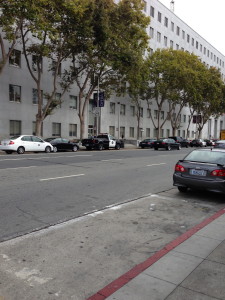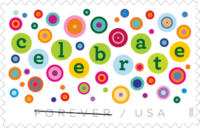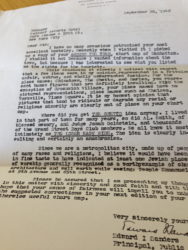
Each of us, as a member of a democratic society, is party to a social contract that requires us to respond to a summons to court to serve on a jury. Recently, I served as a juror in a criminal case that was tried in San Francisco.
There are many levels of communication in a jury trial. When called upon as a potential juror, the first correspondence one receives is the summons, which is sent by U.S. Mail. A jury summons in San Francisco may come as a result of holding a California State Driver’s License, or being a registered voter. A large pool of potential jurors for a trial is selected by computer, but in each active courtroom, only twelve jurors and two alternates ultimately serve on the jury.
It had been a number of years since I last had served as a juror, and while the process is still pretty much the same as in my previous experiences, this recent jury service provided me with an opportunity to view the proceedings and the environment with new eyes.
The Superior Court in San Francisco hears cases in two separate locations. Near the Civic Center, a newer, modern courthouse is dedicated mostly to civil cases. Criminal trials are held in the old Hall of Justice, a boxy, uninviting concrete building located in the area known as South of Market (SoMa). My summons was for the Hall of Justice.
Co-located with the County Jail, the Hall of Justice resides in a bleak environment, five and a half blocks from the Civic Center, on Bryant between Sixth and Seventh Streets. Police and Highway Patrol cars line the street in front of the building and the cars and trucks entering and exiting the nearby freeways blow up clouds of dusts, wreaking havoc on contact lenses.
Sixth Street is a major artery for traffic exiting the I-280 freeway, and also, both currently and historically, it is a gritty, high crime area. For these reasons, I chose to walk down Seventh Street, an evolving neighborhood, as is much of SoMa. Old industrial buildings have been rehabbed or torn down, giving way to new office spaces, condos and apartments. Just below Market Street, the new Federal Building is a modern and striking addition to the neighborhood, juxtaposed with the neo-classic Federal Courthouse on the other side of the street.
Interesting side streets and alleys are scattered along the way, with names like Minna (a name with various meanings, perhaps American Indian, perhaps the name of a pioneer), Tehama (of Indian origin, meaning “high water”), and Natoma (named after an Indian Tribe on the American and Feather Rivers). According to some references, these streets may have been named after the mistresses of prominent politicians in the early days of the city, when “south of the slot” was not a reputable area. Many of these side streets are lined with the classic Victorian residential flats that are characteristic of many San Francisco neighborhoods.
Dotted along the way there is a sprinkling of fashionable coffee shops and cafes, such as Sightglass Coffee, which, according to one Yelp review, is “what I picture in my mind of hipster coffee boutiques at their best,” and Brainwash Café and Laundromat, which serves up tasty sandwiches, salads and espresso and tea. A person can even do their laundry at the same time. Turtle Tower, Basil Thai and others provide Southeast Asian cuisine options.
Across the street from the courthouse, it was a pleasant surprise to find Caffe Roma (also located in San Francisco’s North Beach and in the city of Millbrae, south of the City), a welcome morning stop and oasis. But with the generous lunch break of an hour and a half (designed to give both judges and attorneys the opportunity to further review and prepare for the courtroom), it also was enjoyable to roam further south, exploring the design district, and visit one of my favorite shops, Dandelion, a boutique store filled with unique cards, teas, books, home accessories and more.
The pool of potential jurors in the Jury Assembly Room at the Hall of Justice represents a broad cross section of the community, including workers in such fields as technology, nursing, law, business and civil service, as well as a diversity of age, ethnicity, gender preference and more. On the day that I appeared, a group of approximately eighty people reported for service.
The judge was a good communicator who brought a less formal atmosphere to the proceedings. No rising was required when he entered the courtroom. In fact, we were told to remain seated. Prior to the trial, he walked among the assembled jurors, in both the assembly room as well as the courtroom. He thanked us for being there and for our patience in waiting for the proceedings to begin. His features were both friendly and judicial at the same time – in a broad sense, non-judgmental. The attorneys were both young, attractive women who earnestly pleaded their respective arguments, one representing the District Attorney and the other from the Public Defender’s Office.
A jury trial includes many opportunities for correspondence and communication. The jurors were provided spiral notebooks to use for note taking; the notebooks never left the courthouse, could not be taken home, and were confiscated when the trial was over. For this inveterate note taker, the reporter-style notebook was very helpful.
During the trial, in addition to oral arguments and testimony from witnesses and expert witnesses, we viewed video and documents, including logs, charts and graphs. We received oral and written instructions from the judge.
Jurors, while admonished to not speak about the trial while it was in progress, either with outsiders or fellow jurors, were free to interact socially with one another, in the hallways, the assembly room, and over lunch. It was a pleasure to meet many highly intelligent, conscientious and dedicated people, most of whom I would happily meet again.
There are, however, many frustrating moments when serving as a juror Perhaps the most stressful part is the deliberation. Not everyone sees the facts or distills them in the same manner. We all bring our personal biases and point of view to the process, some more than others. Usually, we can reach consensus, but a jury verdict must be unanimous, and sometimes, this does not happen.
To serve on a jury, we give up our time and, in many cases, our income. Ultimately, however, I believe in the civic contract, and in the responsibility that we hold with our peers to participate in the process. Never have I come away without having learned something new, and this experience was no exception.
Sources:
Louis K. Loewenstein, Streets of San Francisco; the origins of street and place names. 1984 Wilderness Press Berkeley 3rd edition April 1996.





Kathleen
21 Aug 2014I have Jury Duty next week. You make it sound so interesting!!!
Vivian
8 Sep 2014Not even near my latest experience with jury duty! During the jury selection process several of us felt the judge was condescending and unrespectful of our opinions. And, she talked of her own experience as if to make us feel that she’s human too and she has feelings and opinions but has the strength to not let them influence her in performing her duty as a judge, such as we should do in our duty as potential jurors.